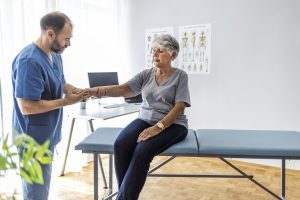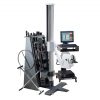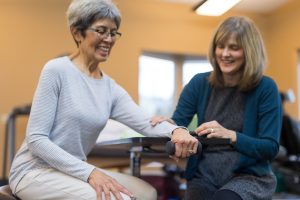
Dupuytren’s Contracture: A Debilitating Condition of the Hand
Treatment GuidelinesDupuytren’s can mimic a few other common hand conditions. In this post, we’ll take a deeper look at Dupuytren’s Contracture and cover some key topics related to diagnosing and treating this condition.
Named for a French surgeon from the 1800’s, Dupuytren’s Contracture (also known as Dupuytren’s Disease or simply Dupuytren’s) is a debilitating hand condition.1 This issue primarily affects males over the age of 50 of European descent. However, Dupuytrens can occur in anyone, and it has also been associated with conditions and lifestyle factors such as:
- Diabetes
- Alcoholism
- Heart and vascular issues
- Smoking
Dupuytren’s can mimic a few other common hand conditions. That being said, once you’ve seen a few people with the ailment, diagnosis and treatment are fairly straightforward.2
In this post, we’ll take a deeper look at Dupuytren’s Contracture and cover some key topics related to diagnosing and treating this condition.
Diagnosing Dupuytren’s Disease
Dupuytren’s Contracture occurs due to a thickening of the fascia on the palmar side of the hand. As a result of this thickening, the affected fingers will often move into a flexed position, which tends to get worse over time.3
However, multiple different conditions lead to flexed, seemingly stuck fingers. For instance, stenosing tenosynovitis (trigger finger) may affect the flexor tendons of one or more fingers, leading to the curling of said digits.4 Additionally, injuries to the median or ulnar nerve may present similarly to Dupuytren’s.
Unfortunately, there aren’t many accurate, specific tests for Dupuytren’s. Often, the clinician will need to simply rule out other common conditions and make a diagnosis based on patient history, functional ability, and any other information available.
Below, I’ll list a few tests and diagnostic methods that can be used for this condition. However, it bears repeating that these tests should not be relied upon in isolation for a diagnosis of Dupuytren’s.
Tabletop Test
A simple and informal measurement, the tabletop test requires the patient to lay his hand on a flat surface, palmar side down. If he is unable to extend his fingers, creating a flat hand, this is considered a positive finding indicative of Dupuytren’s.5
As you might have guessed, there hasn’t been a ton of research done on this special test. Seeing as it is a very basic assessment, it’s not to be relied upon for diagnostic purposes in the absence of other data.
Palpation
Palpating the palm can help to identify some of the characteristic nodules and tissue thickening seen in Dupuytren’s contracture. Palpation (when combined with visual inspection, detailed below) is one of the most crucial aspects of the evaluation. Identifying the deformity through palpation can go a long way toward making a diagnosis.
Visual Inspection
Dupuytren’s can affect one or more fingers. However, it most commonly affects the fourth and fifth digits. The affected flexor tendon will often appear to be thick, tight, and may look to be almost pressing through the skin, like a taut cord.
By simply visually inspecting the palmar surface of the hand, clinicians can be fairly confident in their diagnosis of Dupuytren’s.
Management of Dupuytren’s
Treating Dupuytren’s is a tricky prospect. Patients frequently need surgery, but some conservative treatments can provide relief.,7 Below, we’ll review some of the common non-surgical and surgical options available for Dupuytren’s.
Massage
Some patients with Dupuytren’s elect to pursue non-surgical options. Massage is often the first go-to technique. Various massage methods can work, but transverse friction massage seems to be the obvious choice for this condition.
By applying pressure perpendicularly to the line of the affected tendons, the rehab professional can provide relief from the constant tightness present in the condition.8
Exercise
Especially in the early stages of Dupuytren’s, exercise can preserve the strength and mobility. While it might not counteract the progressive flexion, exercise can keep the patient as active and functional as possible.
Exercise is also often indicated after injection or surgery. Resuming flexibility and strengthening exercise is a key component of the rehab process.
Surgery
Surgery for Dupuytren’s seeks to release the trapped tendons.9 Depending on the patient’s age and the severity of the condition, surgery can significantly help patients find relief and improve function.
Unfortunately, even with surgical correction, the contractures may reoccur. This may necessitate multiple surgeries.
Injections
Collagenase injections are a popular treatment option for Dupuytren’s. Interestingly, these injections seem to be effective for many people, leading to long-term improvement.10 These treatments tend to be well-liked by both patients and providers due to the long-lasting effects and because they provide an alternative to surgery.
Manipulation
Often paired with injections, manipulation of the affected finger joints can provide relief and improved mobility. Manipulations can be performed soon after the injection, or even up to seven days post-injection. Some studies cite positive results regardless of the timing of the manipulation.11
Conclusion
Dupuytren’s contracture is a progressive condition which affects the tendons of the hand. This issue is often diagnosed through a combination of visual examination, palpation, physical testing, and ruling out other similar issues.
Treatment for the condition often involves surgery and/or collagenase injections. While rehab professionals may not have many tools to combat the disease progression, they certainly can help clients maintain strength and mobility in the hand after surgery or injection. Also, nonsurgical options are necessary for those patients for whom surgery and injections are contraindicated.
Bennett Richardson, PT, DPT, CSCS is a Physical Therapist and writer. He is the owner of Richardson PT LLC, a mobile, cash-based physical therapy service out of Pittsburgh, PA. Ben is passionate about many health-related topics including weight loss and athletic performance. To get in touch with Ben, visit www.richardsonpt.com
References
- Salari, N., Heydari, M., Hassanabadi, M. et al. The worldwide prevalence of the Dupuytren disease: a comprehensive systematic review and meta-analysis. J Orthop Surg Res 15, 495 (2020). https://doi.org/10.1186/s13018-020-01999-7
- Dutta A, Jayasinghe G, Deore S, Wahed K, Bhan K, Bakti N, Singh B. Dupuytren’s Contracture – Current Concepts. J Clin Orthop Trauma. 2020 Jul-Aug;11(4):590-596. doi: 10.1016/j.jcot.2020.03.026. Epub 2020 Apr 15. PMID: 32684695; PMCID: PMC7355095.
- Grazina R, Teixeira S, Ramos R, Sousa H, Ferreira A, Lemos R. Dupuytren’s disease: where do we stand? EFORT Open Rev. 2019 Feb 20;4(2):63-69. doi: 10.1302/2058-5241.4.180021. PMID: 30931150; PMCID: PMC6404791.
- Gehring MB, Yang K, Zein Eddine SB, Hettinger PC. Abstract: Correlation between Stenosing Tenosynovitis and Dupuytren’s Contracture in the Hand. Plast Reconstr Surg Glob Open. 2018 Sep 26;6(9 Suppl):65-66. doi: 10.1097/01.GOX.0000546804.58887.89. PMCID: PMC6212047.
- Field PL, Hueston JT. Articular cartilage loss in long-standing immobilisation of interphalangeal joints. Br J Plast Surg. 1970 Apr;23(2):186-91. doi: 10.1016/s0007-1226(70)80036-4. PMID: 5428674.
- Eckerdal, D., Nivestam, A. & Dahlin, L.B. Surgical treatment of Dupuytren’s disease – outcome and health economy in relation to smoking and diabetes. BMC Musculoskelet Disord 15, 117 (2014). https://doi.org/10.1186/1471-2474-15-117
- Ball C, Izadi D, Verjee LS, Chan J, Nanchahal J. Systematic review of non-surgical treatments for early dupuytren’s disease. BMC Musculoskelet Disord. 2016 Aug 15;17(1):345. doi: 10.1186/s12891-016-1200-y. PMID: 27526686; PMCID: PMC4986253.
- Christie, W. S., Puhl, A. A., & Lucaciu, O. C. (2012). Cross-frictional therapy and stretching for the treatment of palmar adhesions due to Dupuytren’s contracture: A prospective case study. Manual Therapy, 17(5), 479–482. https://doi.org/10.1016/j.math.2011.11.001
- Aykut S, Baydar M, Büyük AF, Öztürk İA, Özden E, Öztürk K. Surgical treatment results for dupuytren’s disease. Acta Ortop Bras. 2017 May-Jun;25(3):71-73. doi: 10.1590/1413-785220172503164827. PMID: 28642664; PMCID: PMC5474406.
- Nordenskjöld J, Lauritzson A, Åkesson A, Atroshi I. Collagenase injections for Dupuytren disease: 3-year treatment outcomes and predictors of recurrence in 89 hands. Acta Orthop. 2019 Dec;90(6):517-522. doi: 10.1080/17453674.2019.1663472. Epub 2019 Sep 10. PMID: 31500473; PMCID: PMC6844429.
- Reynolds B, Tobin V, Smith JA, Rozen WM, Hunter-Smith DJ. The effectiveness of manipulation of fingers with Dupuytren’s contracture 7 days after collagenase clostridial histolyticum injection. Journal of Hand Surgery (European Volume). 2020;45(3):286-291. doi:10.1177/1753193419890770





